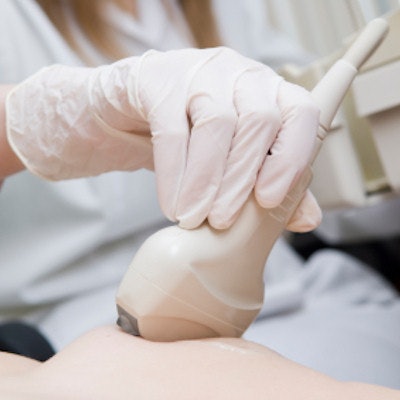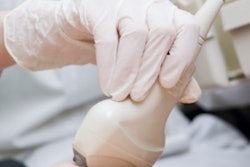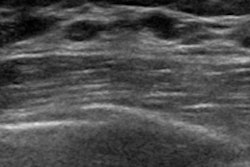
Two different ultrasound elastography techniques -- strain elastography (SE) and shear-wave elastography (SWE) -- showed high interoperator reproducibility when scanning breast lesions in a new study, published on January 21 in Ultrasound in Medicine and Biology.
Repeatability is critical to test the clinical effectiveness of imaging technologies. In the study, two experienced operators used the same probe on the same ultrasound system to test how reliably SE and SWE showed the same result when imaging breast lesions.
While SE performed slightly better for malignant lesions, both ultrasound elastography techniques demonstrated good to excellent agreement.
"Under the same operating conditions, our results indicated the excellent reproducibility of SE and SWE in assessing breast neoplasms among well-trained operators," wrote the authors, led by Dr. Lu Zhang from the Shanghai Jiaotong University School of Medicine.
Clinicians use SE and SWE to assess the stiffness of masses or tissue, but the two techniques use different methods to acquire images. While SE acquires an image by compressing or pulsing to displace tissue, SWE uses acoustic pressure to create an image of tissue stiffness. The researchers wondered whether these differences would affect interoperator reliability for benign and malignant lesions.
To find out, two blinded radiologists with more than three years of clinical experience performed breast ultrasound examinations on 91 women with pathologically confirmed breast lesions. The researchers excluded women with cystic or mixed lesions, lesions with coarse calcifications, and tumors that exceeded elastography's region of interest.
The radiologists acquired two SE images (nodule outline drawn and not drawn) and three SWE images (quality control, nodule outline drawn, and nodule outline not drawn) using the Resona 7 ultrasound system (Mindray Medical) with an L11-3 probe. An image was deemed satisfactory when the quality control scale at the bottom of the image reached a stable stage.
| Diagnostic performance of SE and SWE | ||||
| Sensitivity | Specificity | |||
| Operator 1 | Operator 2 | Operator 1 | Operator 2 | |
| Elastic score (SE) | 58% | 59% | 95% | 88% |
| Strain ratio (SE) | 71% | 57% | 78% | 92% |
| Mean elastic modulus (SWE) | 58% | 45% | 78% | 93% |
| Max elastic modulus (SWE) | 71% | 52% | 88% | 100% |
| Minimum elastic modulus (SWE) | 48% | 19% | 80% | 95% |
| Standard deviation of elastic modulus (SWE) | 65% | 74% | 87% | 73% |
Both SE and SWE showed satisfactory repeatability, the researchers found. For SE, operators' evaluation results showed no significant difference. For SWE, all scores except for minimum elastic modulus showed promising repeatability.
In addition, specificities were higher than sensitivities for both types of ultrasound, and both SE and SWE performed well on all types of lesions.
"It is generally believed that the reproducibility of SE is lower than that of SWE," the authors wrote. "However, our study found that the reproducibility of both SE and SWE breast lesions is very satisfactory except for [minimum elastic modulus of SWE], which may explain the very similar diagnostic performance of SE and SWE by the two operators."
One limitation of the study was its small sample size, and the researchers urged future, larger studies to confirm their findings. In addition, SE and SWE should still be considered adjunct modalities to B-mode ultrasound because of the high specificity and low sensitivity findings.
"In our study, SE and SWE had high specificity but relatively low sensitivity, which reminds us not to overestimate the value of elastography in the diagnosis of breast nodules," they wrote.
"We still need to rely on B-mode ultrasound with elastography as an auxiliary model."



















